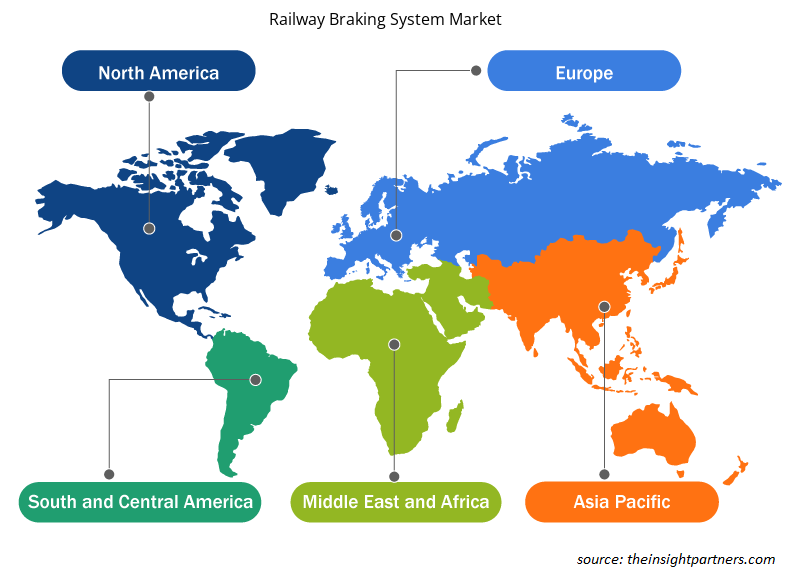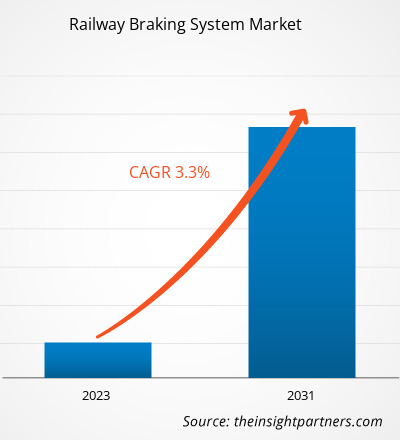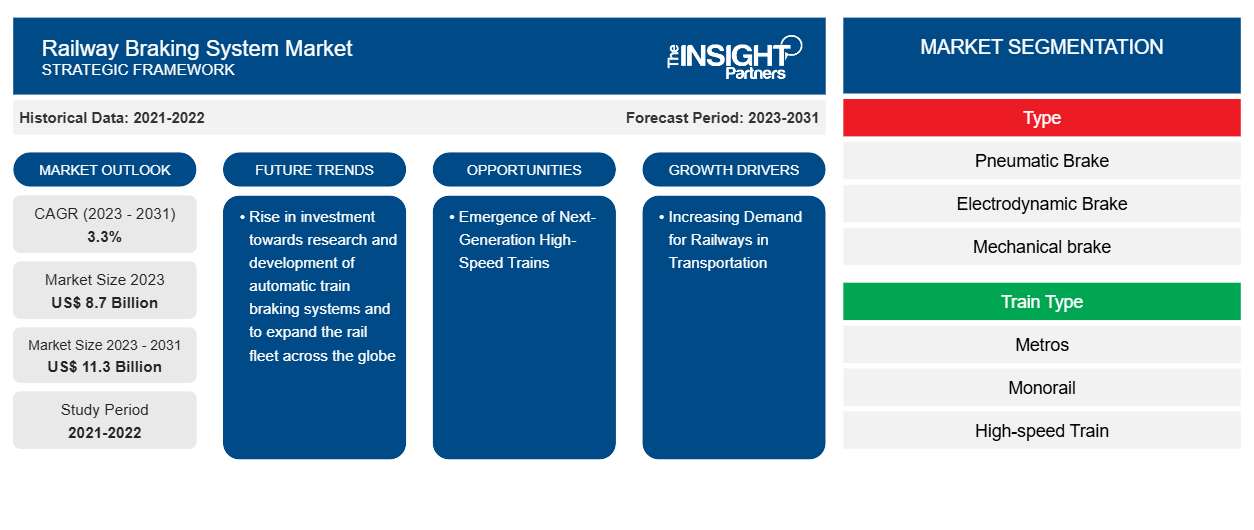من المتوقع أن يصل حجم سوق أنظمة الكبح للسكك الحديدية إلى 11.3 مليار دولار أمريكي بحلول عام 2031 من 8.7 مليار دولار أمريكي في عام 2023. ومن المتوقع أن يسجل السوق معدل نمو سنوي مركب بنسبة 3.3٪ في الفترة 2023-2031. يعد ارتفاع الاستثمار في البحث والتطوير لأنظمة الكبح الأوتوماتيكية للقطارات وتوسيع أسطول السكك الحديدية في جميع أنحاء العالم من بين الاتجاهات الرئيسية التي تقود سوق أنظمة الكبح للسكك الحديدية.
تحليل سوق أنظمة الكبح للسكك الحديدية
عوامل مثل الطلب المتزايد على النقل بالسكك الحديدية بين الأفراد كوسيلة للنقل ومشاريع السكك الحديدية المتنامية لبناء خطوط سكك حديدية جديدة وخطوط مترو الأنفاق والقطار الأحادي والسكك الحديدية عالية السرعة. تستمر المشاريع إلى جانب الاستثمار الحكومي المتزايد لتوسيع قطاع السكك الحديدية في تعزيز قطاع السكك الحديدية. مع نمو قطاع السكك الحديدية ، يتلقى نطاق دمج أنظمة السلامة، بما في ذلك الفرامل، زخمًا كبيرًا. بالإضافة إلى ذلك، فإن وصول أنظمة الكبح الأوتوماتيكية للقطارات، وعمليات القطارات الأوتوماتيكية، والقطارات عالية السرعة من الجيل التالي في الاقتصادات الناشئة هو عامل آخر يجذب نمو سوق أنظمة الكبح. علاوة على ذلك، فإن العدد المتزايد من حزم الحجم والتجارة في الدول يؤثر على استخدام السكك الحديدية، لأنها أرخص وسيلة نقل مقارنة بالطرق الجوية. لذلك، مع ازدهار أعمال الشحن، زادت أيضًا دورة تطوير السكك الحديدية للشحن. مع التطور المتزايد للسكك الحديدية الخفيفة، سيزداد أيضًا تكامل أنظمة الكبح.
نظرة عامة على سوق أنظمة الكبح للسكك الحديدية
في ضوء الاتجاهات الرئيسية الكبرى مثل الاستدامة والتحضر ومركبات التنقل والرقمنة، تشهد صناعة النقل نموًا هائلاً. ستفيد الاتجاهات المذكورة أعلاه قطاع السكك الحديدية من خلال توفير فرص نمو مستدامة طويلة الأجل للتنقل في المستقبل. بالإضافة إلى ذلك، نظرًا لمعايير السلامة والجودة الصارمة المتضمنة في قطاع السكك الحديدية، فإن تكامل الأنظمة والمعدات المتقدمة آخذ في الازدياد. في قطاع السكك الحديدية، تعد المسارات ذات التثبيت المرن المزدوج والقيادة الآلية وكابلات الطاقة العلوية / السكك الحديدية الثالثة وأنظمة إشارات التحكم في القطارات القائمة على الاتصالات من بين التقنيات القليلة التي يتم دمجها في خطوط المترو. سيلعب دمج مثل هذه التقنيات المتقدمة في قضبان المترو دورًا أساسيًا في زيادة نطاق دمج أنظمة كبح السكك الحديدية.
قم بتخصيص هذا التقرير ليناسب متطلباتك
ستحصل على تخصيص لأي تقرير - مجانًا - بما في ذلك أجزاء من هذا التقرير، أو تحليل على مستوى الدولة، وحزمة بيانات Excel، بالإضافة إلى الاستفادة من العروض والخصومات الرائعة للشركات الناشئة والجامعات
-
احصل على أهم اتجاهات السوق الرئيسية لهذا التقرير.ستتضمن هذه العينة المجانية تحليلاً للبيانات، بدءًا من اتجاهات السوق وحتى التقديرات والتوقعات.
محركات وفرص سوق أنظمة الكبح للسكك الحديدية
تزايد الطلب على السكك الحديدية في النقل
يعتبر النقل بالسكك الحديدية بشكل أساسي وسيلة نقل آمنة ومأمونة واقتصادية عند مقارنتها بالنقل البري. وفيما يتعلق بعوامل مثل الدقة العالية والقدرة على تغطية أقصى مساحة جغرافية، فإن الطلب بين المسافرين آخذ في النمو. ولضمان سلامة القطارات والبضائع والركاب، تعد أنظمة الكبح من بين الأنظمة المستخدمة في السكك الحديدية. بالإضافة إلى ذلك، تساهم المشاريع الحكومية مثل مترو دبي روت 2020 لبناء البنية التحتية الجديدة للسكك الحديدية وزيادة الاستثمارات لتوسيع اتصال القطارات في نمو قطاع السكك الحديدية. كما يتزايد الطلب على السكك الحديدية لنقل البضائع. ومع زيادة حجم الطرود والبضائع المنقولة عبر السكك الحديدية، يتزايد عدد القطارات. إن النقل الضخم للبضائع عبر السكك الحديدية يخلق فرصًا مربحة لكل من مصنعي القطارات وغيرها من أنظمة القطارات. وبالتالي، فإن هذا الجانب من زيادة نقل البضائع وركاب السكك الحديدية يعزز نمو قطاع السكك الحديدية ويحفز حكومات البلدان على الاستثمار بكثافة في مشاريع السكك الحديدية.
ظهور الجيل القادم من القطارات عالية السرعة
في زمن التطورات التكنولوجية المستمرة، تشهد صناعة السكك الحديدية في جميع أنحاء العالم تقنيات وأنظمة جديدة تلعب دورًا حاسمًا في تحويل القطاع بأكمله. على سبيل المثال، في أبريل 2024، تكشف كوريا الجنوبية عن الجيل التالي من قطار الرصاصة عالي السرعة. تبلغ السرعة القصوى لهذا القطار 320 كيلومترًا في الساعة. بالإضافة إلى ذلك، في أكتوبر 2023، كشفت فرنسا عن الجيل التالي من قطارات TGV M عالية السرعة، ومن المتوقع أن تدخل الخدمة في عام 2025. ومن المتوقع أن يؤدي هذا التقدم التكنولوجي وظهور القطارات عالية السرعة في جميع أنحاء العالم إلى دفع الطلب على سوق أنظمة فرامل السكك الحديدية خلال فترة التنبؤ.
كما أن ظهور الجيل القادم من فرامل الأقراص الهوائية يشق طريقه لتحويل السكك الحديدية. بالإضافة إلى ذلك، في نظام الكبح المباشر، يتم نقل أوامر الفرامل بسرعة مع فترة زمنية أقصر. علاوة على ذلك، تعمل شركة Shift2Rail المشتركة على حل اختبار الفرامل الرقمي، والذي من شأنه أن يسمح للسائقين باختبار الفرامل من مقصوراتهم من خلال جهاز لوحي. سيساعد حل اختبار الفرامل الرقمي هذا في توفير الوقت وتكاليف العمالة مع تعزيز المرونة والسلامة. في فترة التنقل من الجيل القادم، فإن ظهور القطارات عالية السرعة وحلول اختبار الفرامل الرقمية وفرامل الجيل القادم من شأنه أن يساعد في جعل قطاع السكك الحديدية جاهزًا للمستقبل. ومن المتوقع أن تحتل جميع الجوانب المذكورة مكانة مهمة في تبني أنظمة فرامل السكك الحديدية.
تقرير تحليل تجزئة سوق أنظمة الكبح للسكك الحديدية
إن القطاعات الرئيسية التي ساهمت في اشتقاق تحليل سوق نظام الكبح للسكك الحديدية هي النوع ونوع القطار.
- وفقًا للنوع، تم تقسيم سوق أنظمة فرامل السكك الحديدية إلى فرامل هوائية وفرامل كهروديناميكية وفرامل ميكانيكية وفرامل كهرومغناطيسية. احتلت شريحة بوصات الفرامل الهوائية حصة سوقية أكبر في عام 2023.
- بناءً على نوع القطار، تم تقسيم سوق أنظمة الكبح للسكك الحديدية إلى مترو الأنفاق، والقطار الأحادي، والقطارات عالية السرعة، والسكك الحديدية الخفيفة/الترام، وقطارات الشحن. احتل قطاع خطوط السكك الحديدية الخفيفة/الترام حصة سوقية أكبر في عام 2023.
تحليل حصة سوق أنظمة الكبح للسكك الحديدية حسب المنطقة الجغرافية
ينقسم النطاق الجغرافي لتقرير سوق نظام الفرامل للسكك الحديدية بشكل أساسي إلى خمس مناطق: أمريكا الشمالية وأوروبا وآسيا والمحيط الهادئ والشرق الأوسط وأفريقيا وأمريكا الجنوبية.
ستهيمن منطقة آسيا والمحيط الهادئ على سوق أنظمة الكبح للسكك الحديدية في عام 2023. تشمل منطقة آسيا والمحيط الهادئ أستراليا والصين واليابان والهند وكوريا الجنوبية وبقية منطقة آسيا والمحيط الهادئ. تدعم الاقتصادات المستقرة والتقدم التكنولوجي نمو مجموعة متنوعة من الصناعات والأسواق في المنطقة. أصبحت اتصالات شبكة السكك الحديدية الإقليمية في منطقة جنوب شرق آسيا أفضل بسبب تنفيذ العديد من المشاريع لربط الطرق الحالية في إطار شبكة السكك الحديدية في عموم آسيا. ستضمن مشاريع السكك الحديدية الجديدة التي تدعمها وتخطط لها حكومة الصين الاتصالات بين المدن الكبرى في البر الرئيسي لجنوب شرق آسيا - الممتدة من كونمينغ في الصين إلى بانكوك وسنغافورة وكوالالمبور، مع خط مركزي من فيينتيان في لاوس إلى بانكوك؛ خط شرقي عبر مدينة هانوي ومدينة هوشي منه في فيتنام ومدينة بنوم بنه في كمبوديا؛ وخط غربي عبر يانجون في ميانمار.
كما تخطط إندونيسيا والفلبين لمشاريع سكك حديدية لربط المدن الرئيسية بجزرها الرئيسية. وتقوم قطاعات السكك الحديدية في الفلبين وتايلاند والصين والهند باستثمارات ضخمة في أراضيها لتعزيز النقل بالسكك الحديدية من خلال دمج التقنيات المتقدمة. بالإضافة إلى ذلك، تعد اليابان من بين الدول الكبرى التي تستخدم السكك الحديدية عالية السرعة لتقليل الازدحام على الطرق ومساعدة الركاب على توفير الوقت والمال.
رؤى إقليمية حول سوق أنظمة الكبح للسكك الحديدية
لقد قام المحللون في Insight Partners بشرح الاتجاهات والعوامل الإقليمية المؤثرة على سوق أنظمة الكبح للسكك الحديدية طوال فترة التوقعات بشكل شامل. يناقش هذا القسم أيضًا قطاعات سوق أنظمة الكبح للسكك الحديدية والجغرافيا في جميع أنحاء أمريكا الشمالية وأوروبا ومنطقة آسيا والمحيط الهادئ والشرق الأوسط وأفريقيا وأمريكا الجنوبية والوسطى.

- احصل على البيانات الإقليمية المحددة لسوق أنظمة الكبح للسكك الحديدية
نطاق تقرير سوق أنظمة الكبح للسكك الحديدية
| سمة التقرير | تفاصيل |
|---|---|
| حجم السوق في عام 2023 | 8.7 مليار دولار أمريكي |
| حجم السوق بحلول عام 2031 | 11.3 مليار دولار أمريكي |
| معدل النمو السنوي المركب العالمي (2023 - 2031) | 3.3% |
| البيانات التاريخية | 2021-2022 |
| فترة التنبؤ | 2023-2031 |
| القطاعات المغطاة |
حسب النوع
|
| المناطق والدول المغطاة |
أمريكا الشمالية
|
| قادة السوق وملفات تعريف الشركات الرئيسية |
|
كثافة اللاعبين في السوق: فهم تأثيرها على ديناميكيات الأعمال
يشهد سوق أنظمة الكبح للسكك الحديدية نموًا سريعًا، مدفوعًا بالطلب المتزايد من المستخدم النهائي بسبب عوامل مثل تفضيلات المستهلك المتطورة والتقدم التكنولوجي والوعي المتزايد بفوائد المنتج. ومع ارتفاع الطلب، تعمل الشركات على توسيع عروضها والابتكار لتلبية احتياجات المستهلكين والاستفادة من الاتجاهات الناشئة، مما يؤدي إلى زيادة نمو السوق.
تشير كثافة اللاعبين في السوق إلى توزيع الشركات أو المؤسسات العاملة في سوق أو صناعة معينة. وهي تشير إلى عدد المنافسين (اللاعبين في السوق) الموجودين في مساحة سوق معينة نسبة إلى حجمها أو قيمتها السوقية الإجمالية.
الشركات الرئيسية العاملة في سوق نظام الفرامل للسكك الحديدية هي:
- داكو-CZ
- شركة أكيبونو لصناعة الفرامل المحدودة
- أمستيد للسكك الحديدية
- شركة كنور بريمس
- شركة نابتيسكو
- شركة سيبر لخدمات السكك الحديدية المحدودة
إخلاء المسؤولية : الشركات المذكورة أعلاه ليست مرتبة بأي ترتيب معين.

- احصل على نظرة عامة على أهم اللاعبين الرئيسيين في سوق أنظمة الكبح للسكك الحديدية
أخبار سوق أنظمة الكبح للسكك الحديدية والتطورات الأخيرة
يتم تقييم سوق أنظمة الكبح للسكك الحديدية من خلال جمع البيانات النوعية والكمية بعد البحث الأولي والثانوي، والتي تتضمن منشورات الشركات المهمة وبيانات الجمعيات وقواعد البيانات. فيما يلي قائمة بالتطورات في سوق أنظمة الكبح للسكك الحديدية والاستراتيجيات:
- في يناير 2024، طلبت شركة Wabtec Corporation نظام فرامل بقيمة 157 مليون دولار أمريكي من شركة Siemens India Private Limited. ومن خلال اتفاقية التوريد هذه، ستوفر شركة Siemens Limited أنظمة فرامل ذات أداء تشغيلي وكفاءة وأمان محسّن للخط الجديد المكون من 1200 قاطرة كهربائية.
- في أكتوبر 2023، أطلقت شركة Siemens Mobility نظام فرامل جديد خالٍ من الهواء. يتيح نظام الفرامل الجديد التحكم الكهربائي الكامل في فرامل الاحتكاك في مركبات السكك الحديدية ويعزز مجموعة منتجات الشركة.
تقرير سوق أنظمة الكبح للسكك الحديدية يغطي النتائج المتوقعة
يوفر تقرير "حجم سوق نظام الكبح للسكك الحديدية والتوقعات (2021-2031)" تحليلاً مفصلاً للسوق يغطي المجالات التالية:
- حجم السوق والتوقعات على المستويات العالمية والإقليمية والوطنية لجميع قطاعات السوق الرئيسية التي يغطيها النطاق
- ديناميكيات السوق مثل المحركات والقيود والفرص الرئيسية
- الاتجاهات المستقبلية الرئيسية
- تحليل مفصل لقوى بورتر الخمس
- تحليل السوق العالمي والإقليمي الذي يغطي اتجاهات السوق الرئيسية واللاعبين الرئيسيين واللوائح والتطورات الأخيرة في السوق
- تحليل المشهد الصناعي والمنافسة الذي يغطي تركيز السوق، وتحليل خريطة الحرارة، واللاعبين البارزين، والتطورات الأخيرة
- ملفات تعريف تفصيلية للشركة مع تحليل SWOT
- التحليل التاريخي (سنتان)، سنة الأساس، التوقعات (7 سنوات) مع معدل النمو السنوي المركب
- تحليل PEST و SWOT
- حجم السوق والقيمة / الحجم - عالمي، إقليمي، بلد
- الصناعة والمنافسة
- مجموعة بيانات إكسل
التقارير الحديثة
شهادات العملاء
سبب الشراء
- اتخاذ قرارات مدروسة
- فهم ديناميكيات السوق
- تحليل المنافسة
- رؤى العملاء
- توقعات السوق
- تخفيف المخاطر
- التخطيط الاستراتيجي
- مبررات الاستثمار
- تحديد الأسواق الناشئة
- تحسين استراتيجيات التسويق
- تعزيز الكفاءة التشغيلية
- مواكبة التوجهات التنظيمية























 احصل على عينة مجانية ل - سوق أنظمة فرامل السكك الحديدية
احصل على عينة مجانية ل - سوق أنظمة فرامل السكك الحديدية